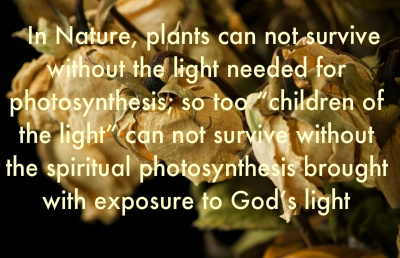The Physical Picture:
Life is often such a fragile thing. Many living things struggle to hold onto it despite physical, psychological and spiritual threats and eventually death. Most biological life as we know it is directly or indirectly dependent on light for survival. Green plants and creatures dependent on those green things (including people) realize that sunlight is the principal natural light form without which we can not survive. Sustained darkness results in death for those things dependent on the light. Life without sunlight is very limited or impossible for those life forms that need the light to function and stay alive. Just as light brings life, so too sustained light deprivation, or darkness, brings death.
What is it about sunlight that creates life? Clearly plants require sunlight to perform their life purposes: growth, maturation and reproduction. Without sunlight there is neither nourishment nor growth. This nourishment process is referred to as “photosynthesis.”
Photosynthesis is defined in Merriam Webster’s Collegiate Dictionary (10th Edition) as: the “…formation of carbohydrates from carbon dioxide and a source of hydrogen (as water) in the chlorophyll containing tissues of plants exposed to light.” These carbohydrates provide nourishment and create the cells and tissue that provide growth to the plant, allowing it to complete its life cycle of seed, seedling, flower, fruit and seed again – but only in the presence of sunlight.
The Spiritual Picture:
It’s easy to see how critical light is to the many natural forms of life around us; but I wonder if biologists recognize the parallel that photosynthesis suggests about our spiritual health and well-being. As a devout Christian, I’ve come to recognize that light of a different sort is also critical to my spiritual growth, particularly if I am to truly be a “child of the light” and “let this little light of mine….shine.” 
Light has traditionally been used to indicate life and good. In verses 3-4 and 14-17 of Chapter 1 of the Bible’s Book of Genesis, God creates the light and sees how good it is. Throughout the New Testament, Jesus is portrayed as the “light of the world.” Clearly, both God and Jesus are critical sources of spiritual life to those wishing to live “in the light.” Like the plants of the earth, we also will wilt and die without that light. This parallel speaks strongly of the importance of staying in the light and not getting trapped in the darkness, for in the darkness death awaits.
There is much we can learn from our natural world. How much like the plants are we people, where our spiritual health and well-being are concerned? Spiritual light provides “spiritual photosynthesis;” in that we are nourished and sustained when we remain in the light of a strong relationship with God. It’s easy to see why historically the lack of light, or darkness, is associated with evil and death. The absence of light brings death to those who remain in the darkness. In Nature, plants can not survive without the light needed for photosynthesis; so too “children of the light” can not survive without the spiritual photosynthesis brought with exposure to God’s light.
As we near the end of this calendar year, the seasons of Thanksgiving and Christmas approach. These seasons remind us of the need to be thankful for what we have and the need to repent and seek forgiveness for past wrongs. In so doing so, we, His “children of the light” around the world, celebrate God’s love for us by basking in that light and striving to share it with others.



